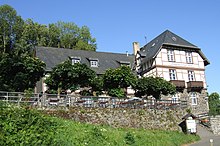Löwenburger Hof
The Löwenburger Hof is a restaurant and hotel building in Bad Honnef , a town in the Rhein-Sieg district in North Rhine-Westphalia , which goes back to the building and cattle yard of the Löwenburg . In 1909/10 it was rebuilt as a hotel. The lion Hof stands as a monument under monument protection .
location
The Löwenburger Hof is located on the northern slope of the Löwenburg ( 455 m above sea level ) with the castle ruins of the same name at 355 m above sea level. NHN , directly above the 345 m above sea level. NHN highest pass in the Siebengebirge (between Löwenburg and Lohrberg ). To the east, at the beginning of the Einsiedlertal, there is an extensive orchard area ("Löwenburgwiese"), while the Rhöndorfer Tal, which descends a good three kilometers to Rhöndorf , begins to the northwest . The farm is accessible via a one kilometer long paved forest road from Margarethenhöhe .
history
As a so-called construction and cattle yard, the Löwenburger Hof was the farm building of the medieval Löwenburg, which was destroyed at the end of the 16th century. He was one of the scorn forest area called around the hilltop, which covers an area of 125 in 1704 morning included. In the yard one was probably early Serviced with dairy operated. At the end of the 18th century, a forester's house was also built. In April 1798 a heavy storm led to the destruction of the cow barn. The subsequent reconstruction took place with the help of rubble stones from the Löwenburg ruins .
Until the beginning of the 19th century the Löwenburger Hof belonged to the Honschaft Rhöndorf in the parish of Honnef. In 1816 the surrounding forest area, including the Löwenburger Hof, fell into state ownership with the transition to Prussia and was subordinated to the Siebengebirge forestry department. It appeared under its current name in the Prussian original cadastre from 1825. In 1843, according to the census, it had a grinding mill and registered eight residents in a residential building. In 1885 the Löwenburgerhof residential area in the city of Honnef had nine residents.
Until 1904 the farm served as the Löwenburg forester's lodge and was the residence and place of work of the Honnef community and city forester, responsible for the Honnef city forest . They also maintained an inn and guesthouse there called Waldwohnungen , for whose operation a special permit existed. Occasionally Queen Sophie also stayed there . The new leasing of the farm took place with the aim of building a larger hotel and restaurant business. For this purpose, a new building was built between 1908 and 1910, the lower part of which is made of natural stones from the Siebengebirge . The forester's house was then torn down, whereas the former barn remained for the time being.
The hotel established itself as an upscale and well-known company, with Konrad Adenauer and Willi Ostermann also regular guests including prominent personalities. In 1962 the agricultural use of the farm and the hotel business were given up, the excursion restaurant remained. The entry of the Löwenburger Hof in the list of monuments of the city of Bad Honnef took place in July 1980. In 1984 the land of about 9,000 m² passed from the state of North Rhine-Westphalia into the possession of the city of Bad Honnef, which in 1987/88 carried out extensive repairs to the exterior let. The city put it up for sale in 2001, which closed on January 1, 2003. The new owner, a local catering company , had extensive renovations carried out.
literature
- Karl Josef Klöhs: Imperial weather on the Siebengebirge . Edition Loge 7, Königswinter 2003, ISBN 3-00-012113-7 , p. 154 .
Web links
Individual evidence
- ↑ List of monuments of the city of Bad Honnef, number A 87
- ↑ J [ohann] J [oseph] Brungs : The city of Honnef and its history . Verlag des St. Sebastianus-Schützenverein, Honnef 1925, p. 171–173 (reprinted 1978 by Löwenburg-Verlag, Bad Honnef).
- ↑ a b Karl Josef Klöhs: "Where the tired hiker can refresh himself" , May 2005 [not bibliographically recorded]
- ^ Wilhelm Fabricius : Explanations of the historical atlas of the Rhine province, 2nd volume: The map of 1789. Bonn 1898, p. 315.
- ^ Wilhelm Bier, Werner Osterbrink (ed.); Wilhelm W. Hamacher : The Löwenburg: Pictures and data on the history of a castle and its masters . edition Wolkenburg, Rheinbreitbach 2004, ISBN 3-934676-16-2 , p. 144.
- ↑ Royal Government of Cologne: overview of the components u. Directory of all localities in the government district of Cologne. Cöln 1845, p. 86 .
- ^ Community encyclopedia for the Kingdom of Prussia , Volume XII Provinz Rheinland, Verlag des Königlich Statistischen Bureaus (Ed.), 1888, page 115
- ↑ Specialty of the house: Stippeföttche salad , General-Anzeiger , July 17, 2008
- ↑ Landschaftsverband Rheinland , Udo Mainzer (ed.): Yearbook of the Rhenish Preservation of Monuments. Volume 38, Cologne 1999, ISBN 3-7666-0177-6 .
- ↑ Löwenburger Hof: Tourist use must remain , General-Anzeiger, 23 November 2001
- ↑ The contract has been awarded , General-Anzeiger, March 18, 2002
Coordinates: 50 ° 39 '56.4 " N , 7 ° 15' 6.7" E


